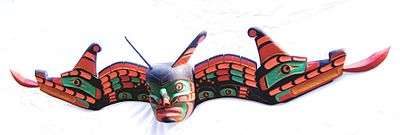Sisiutl

The Sisiutl (Si’sEyuL) is one of the most powerful crests, and mythological creatures in the mythology of the Kwakwaka’wakw, Nuu-chah-nulth, Squamish, Nuxalkmc and various other Indigenous peoples of the Pacific Northwest Coast, and figures prominently in their art, dances and songs. Sisiutl is the god of warrior invincibility, a magic war-canoe that can go underground (Winalagalis), and guardian of the house of the sky people.
Form
Sisiutl are frequently depicted as a two headed sea serpent or snake with a humanoid head (and hands) in the middle of the body. All three heads are surmounted by "horns of power" (also seen on thunderbirds).
NWC whalers told of a powerful whaling charm, a black two headed “worm.”
According to Boas the word for sisiutl in Tsimshian is "Laqaqua'sa" [literally "both sides head"] (Boas, "Vocabularies of the Tlingit, Haida, and Tsimshian" 1891). The soulcatcher (Haboolm Ksinaalgat) of the northern Tsimshian, Tlingit, and Haida peoples exhibits the same body form, and may derive its form from the sisiutl.
Powers
The humanoid central head likely symbolizes Sisiutl’s supernatural shape-shifting powers (most commonly transforming into human form, a self-propelled canoe, or salmon). Sisiutl could also change size from a few centimeters (form of a woodworm), to a span sufficient to block off a bay. As a transformative creature of vast shamanic power, the Sisiutl could travel in and across all boundaries (worlds): land, water, & air. There is a belief among the Coast Salish that Sisiutl employ orca for transportation.
So powerful are Sisiutl, that contact, stepping on one’s slime trail, or even seeing one, was believed to cause sickness or death. According to legend, looking at the sisiutl can turn a person into stone. However, if one kills a Sisiutl, it has healing powers.
Usage
Artifacts commonly adorned with Sisiutl include masks, “flying" props, power boards (dance boards), totem poles, clubs, knives, whistles, house beams, button blankets, setee, drums, wooden belts, pectoral ornaments, headdresses, frontlets, feast bowls, and canoe decorations.
Images or sculptures of Sisiutl were employed to guard canoes and cedar plank longhouses (the Sisiutl sculpture guarding one such house was said to flick its tongues as people approached). Warriors traditionally wear the sisiutl's emblem for protection in battle.
Enemies
Thunderbirds are one of the few predators of Sisiutl. Holly, and spat blood were some of the few implements able to harm a Sisiutl.
Associations
Sisiutl are associated with the salmon (one of Sisiutl’s forms), Winalagilis (warrior spirit), the Sun (“Counselor of the World” steals the Sun’s Sisiutl mask, releasing daylight to the world in one Kwakwaka’wakw myth), the moon, Land-Otter Canoe, woodworm, house of the sky people (Sisiutl guards it). A Sisiutl also guards the house of the Dzunukwa.
Ceremony
Dancers donning the mask of Sisiutl adorn themselves with western hemlock boughs, signifying wildness. Sisiutl masks were often hinged, allowing the serpent ends to simulate lifelike serpentine writhing movements. Sisiutl masks were decorated with flecks of mica, which were believed to be scales shed by Sisiutl (often found on beaches). These mica chips provided an enchanting glittery effect when danced in fire-light.
Tuxw'id (female warrior) dancers often incorporate Sisiutl in their performance, invoking Sisiutl to grant them the power of Winalagalis (warrior spirit): invincibility and immunity from pain. They may be seemingly pulled underground by a Sisiutl, or demonstrate their power by summoning dantsikw (sisiutl) power boards to rise from the earth commemorating the supernatural canoe of Winalagalis (a copper Sisiutl canoe that can travel underground). Supernatural powers bestowed by Sisiutl might be theatrically demonstrated by 'miraculously' surviving burning alive, or being decapitated.
In the Hawinalal, to demonstrate invincibility & immunity from pain, dancers don sisiutl girdles, and are suspended from the rafters of the plank house by skewers pierced through their backs and thighs. Hawinalal dancers also cut themselves with a sisiutl knife. (Boas, "Social Organization...", p. 485).
The Ha'mshamtses ("Eaters-of-the-Ground": secret cannibal society akin to Hamatsa) employs sisiutl transformation masks.
The ME'ila dancer (commemorates a boy who brought back magical treasures from the house of the moon, then remained to live there) carries a sisiutl club.
Gallery
-

Raven/Sisutl transformation mask by Oscar Matilpi, Kwakwaka'wakw Nation, 1996. In the permanent collection of The Children’s Museum of Indianapolis
-

The same Raven/Sisutl transformation mask, open, by Oscar Matilpi, Kwakwaka'wakw Nation, 1996. In the permanent collection of The Children’s Museum of Indianapolis
See also
References
- Boas, Franz. "Kwakiutl Ethnography." 1966. University of Chicago Press. London.
- Jonaitis, Aldona, ed. ."Chiefly Feasts: The Enduring Kwkaiutl Potltach." 1991. AMHH. Seattle.
External links
- Mask Edward Curtis 1914
- Alert Bay grave totem pole
- Button blanket
- Headdress painting.
- Sisiutl board (pre 1900)
- Modern house beam
- Sisiutl as Archetypal Image
